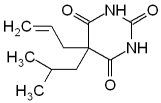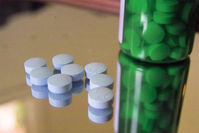We report the case of a 46-year-old woman who came to our emergency department with generalized weakness and abdominal pain. Shortly thereafter, she became hypotensive and had a respiratory arrest that required endotracheal intubation and mechanical ventilation.
The patient had a history of hypertension, migraines, and emphysema. Medications included aspirin, butalbital, and caffeine taken for headaches, and laxatives. A chest radiograph obtained after intubation revealed hyperinflated lungs with diminished vascularity and a flattened diaphragm suggestive of emphysematous lung disease.
Within a few hours after intubation, the patient's respiratory status deteriorated and her oxygen saturation decreased precipitously. Peak airway pressures were elevated and hypotension developed. Because of the potential for pneumothorax, the on-call physician placed a small-bore chest tube connected to a Heimlich 1-way valve. In order for the patient to be transferred for computed tomography, mechanical ventilation was temporarily stopped and aggressive manual ventilation was used. The nursing staff noticed significant resistance during manual ventilation. After placement of the chest tube, computed tomography revealed significant subcutaneous emphysema, a tension pneumothorax, and contralateral mediastinal shift. Multiple bullae and blebs also were present. The patient had a cardiorespiratory arrest and required placement of a conventional large-bore chest tube; resolution of the pneumothorax ensued. Eventually, she was taken to the operating room for bullectomy and repair of ruptured blebs. The postoperative course was complicated by exacerbation of respiratory failure and infection, and the patient died.
In this case, placement of a small-bore chest tube did not resolve a pneumothorax. Moreover, the tube could have potentiated the problem by causing tension pneumothorax. The American College of Chest Physicians consensus statement (1) supports the use of small-bore catheters (<14F) in patients with small to large pneumothoraces whose clinical status is stable. Some patients whose clinical status is unstable can be managed with a small-bore catheter attached to a Heimlich valve if the catheter can provide rapid evacuation of the pleural space. The American College of Chest Physicians recommends the use of size 24F to 28F catheters in patients who appear to be at risk for a large pleural air leak. However, until the computed tomography scan was obtained, we did not know that our patient was high risk.
Small-bore chest tubes, although effective for treating small pneumothoraces, have major limitations. (2) The catheter tip is easily occluded by fluid, by placement of the catheter against the chest wall, or by a kink; all these situations could create a tension pneumothorax. (2-4) Tension pneumothorax could be catastrophic in a patient receiving positive-pressure ventilation. The user's manual provided by the manufacturer of the small-bore chest tube that was used did not refer to that complication. After placement of a conventional chest tube and removal of the small-bore chest tube, the tension pneumothorax in our patient resolved.
We therefore caution physicians and nurses against the use of small-bore chest tubes with a Heimlich valve in patients who are receiving positive-pressure ventilation. If possible, regular-size thoracotomy tubes should be used instead. Furthermore, nursing staff should be cautious in fervent manual overinflation in patients with severe emphysema who are receiving mechanical ventilation, especially during transportation or resuscitation efforts. Such overinflation could markedly increase intrathoracic pressure and eventually lead to excessive amounts of intrinsic positive end-expiratory pressure. (5) In patients with large bullae, blebs, and poor parenchymal integrity, intrinsic positive end-expiratory pressure could cause hypotension, hypoxemia, and poor gas exchange, leading to cardiorespiratory arrest and possibly death. It is therefore recommended that ventilation via a manual resuscitation bag be done with lower tidal volumes and increased time for full exhalation between breaths.
References
1. Baumann MH, Strange C, Heffner JE, et al. Management of spontaneous pneumothorax: an American College of Chest Physicians Delphi consensus statement. Chest. 2001;119:590-602.
2. Conces DJ Jr, Tarver RD, Gray WC, Pearcy EA. Treatment of pneumothoraces utilizing small caliber chest tubes. Chest. 1988;94:55-57.
3. Niemi T, Hannukainen J, Aarnio P. Use of the Heimlich valve for treating pneumothorax. Ann Chir Gynaecol. 1999;88:36-37.
4. Perlmutt LM, Braun SD, Newman GE, et al. Transthoracic needle aspiration: use of a small chest tube to treat pneumothorax. AJR Am J Roentgenol. 1987;148:849-851.
5. Rossi A, Ganassini A, Polese G, Grassi V. Pulmonary hyperinflation and ventilator-dependent patients. Eur Respir J. 1997;10:1663-1674.
Mehrdad M. Behnia, MD
Kitty Garrett, MRN, MSN, CCRN
Authors
Mehrdad M. Behnia is a board-certified pulmonary and critical care physician and Kitty Garrett is a critical care clinical nurse specialist at St. Joseph Hospital, Augusta, Ga.
To purchase reprints, contact The InnoVision Group, 101 Columbia, Aliso Viejo, CA 92656. Phone, (800) 809-2273 or (949) 362-2050 (ext 532); fax, (949) 362-2049; e-mail, reprints@aacn.org.
COPYRIGHT 2004 American Association of Critical-Care Nurses
COPYRIGHT 2004 Gale Group



